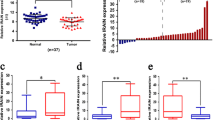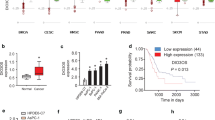Abstract
Pancreatic cancer (PC) is one of the most lethal malignancies worldwide. Tumor suppressor long noncoding RNA on chromosome 8p12 (TSLNC8) is a newly identified long noncoding RNA (lncRNA) and play an important role in human cancers. However, the function and molecular mechanism of TSLNC8 in PC progression remain to be elucidated. Our results showed a significant increase of TSLNC8 expression in PC tissues and cell lines. Upregulation of TSLNC8 expression in PC tissues was closely correlated with TNM stage, distant and lymph node metastasis, and poor prognosis of PC patients. Functional experiments demonstrated that TSLNC8 promoted PC cells proliferation and invasion in vitro, and enhanced PC growth and metastasis in vivo. Mechanistically, TSLNC8 associated with HuR, promoted the binding of HuR with CTNNB1 mRNA and increased the stability of CTNNB1 mRNA, thus activating WNT/β-catenin signaling pathway. Taken together, our present study revealed that oncogenic lncRNA TSLNC8 positively regulate PC growth and metastasis via HuR-mediated mRNA stability of CTNNB1, extending the understanding of PC pathogenesis regulated by lncRNAs.






Similar content being viewed by others
Abbreviations
- PC:
-
Pancreatic cancer
- lncRNAs:
-
Long noncoding RNAs
- EMT:
-
Epithelia-mesenchymal transition
- YB1:
-
Y-box protein
- HCC:
-
Hepatocellular carcinoma
- termed TSLNC8:
-
Tumor suppressor long noncoding RNA on chromosome 8p12
- CCK-8:
-
Cell counting Kit-8
- qRT-PCR:
-
Quantitative real-time PCR
- SDS-PAGE:
-
Sodium dodecyl sulfate–polyacrylamide gel electrophoresis
- ECL:
-
Enhanced chemiluminescence
- RIP:
-
RNA immunoprecipitation
References
Siegel RL, Miller KD, Jemal A. Cancer statistics, 2017. CA Cancer J Clin. 2017;67(1):7–30. https://doi.org/10.3322/caac.21387.
Ilic M, Ilic I. Epidemiology of pancreatic cancer. World J Gastroenterol. 2016;22(44):9694–705. https://doi.org/10.3748/wjg.v22.i44.9694.
Singhi AD, Koay EJ, Chari ST, Maitra A. Early detection of pancreatic cancer: opportunities and challenges. Gastroenterology. 2019;156(7):2024–40. https://doi.org/10.1053/j.gastro.2019.01.259.
Young K, Hughes DJ, Cunningham D, Starling N. Immunotherapy and pancreatic cancer: unique challenges and potential opportunities. Ther Adv Med Oncol. 2018;10:1758835918816281. https://doi.org/10.1177/1758835918816281.
Jonas K, Calin GA, Pichler M. RNA-binding proteins as important regulators of long non-coding RNAs in cancer. Int J Mol Sci. 2020. https://doi.org/10.3390/ijms21082969.
Huang Z, Zhou JK, Peng Y, He W, Huang C. The role of long noncoding RNAs in hepatocellular carcinoma. Mol Cancer. 2020;19(1):77. https://doi.org/10.1186/s12943-020-01188-4.
Jin KT, Yao JY, Fang XL, Di H, Ma YY. Roles of lncRNAs in cancer: focusing on angiogenesis. Life Sci. 2020;252:117647. https://doi.org/10.1016/j.lfs.2020.117647.
Guzel E, Okyay TM, Yalcinkaya B, Karacaoglu S, Gocmen M, Akcakuyu MH. Tumor suppressor and oncogenic role of long non-coding RNAs in cancer. North Clin Istanb. 2020;7(1):81–6. https://doi.org/10.14744/nci.2019.46873.
Deng SJ, Chen HY, Ye Z, Deng SC, Zhu S, Zeng Z, et al. Hypoxia-induced LncRNA-BX111 promotes metastasis and progression of pancreatic cancer through regulating ZEB1 transcription. Oncogene. 2018;37(44):5811–28. https://doi.org/10.1038/s41388-018-0382-1.
Pan S, Shen M, Zhou M, Shi X, He R, Yin T, et al. Long noncoding RNA LINC01111 suppresses pancreatic cancer aggressiveness by regulating DUSP1 expression via microRNA-3924. Cell Death Dis. 2019;10(12):883. https://doi.org/10.1038/s41419-019-2123-y.
Zhang J, Li Z, Liu L, Wang Q, Li S, Chen D, et al. Long noncoding RNA TSLNC8 is a tumor suppressor that inactivates the interleukin-6/STAT3 signaling pathway. Hepatology. 2018;67(1):171–87. https://doi.org/10.1002/hep.29405.
Chen D, Yu X. Long noncoding RNA TSLNC8 suppresses cell proliferation and metastasis and promotes cell apoptosis in human glioma. Mol Med Rep. 2018;18(6):5536–44. https://doi.org/10.3892/mmr.2018.9609.
Fan H, Li J, Wang J, Hu Z. Long non-coding RNAs (lncRNAs) tumor-suppressive role of lncRNA on chromosome 8p12 (TSLNC8) inhibits tumor metastasis and promotes apoptosis by regulating interleukin 6 (IL-6)/signal transducer and activator of transcription 3 (STAT3)/hypoxia-inducible factor 1-alpha (HIF-1alpha) signaling pathway in non-small cell lung cancer. Med Sc Monit. 2019;25:7624–33. https://doi.org/10.12659/MSM.917565.
Qin CX, Yang XQ, Jin GC, Zhan ZY. LncRNA TSLNC8 inhibits proliferation of breast cancer cell through the miR-214-3p/FOXP2 axis. Eur Rev Med Pharmacol Sci. 2019;23(19):8440–8. https://doi.org/10.26355/eurrev_201910_19156.
In H, Solsky I, Palis B, Langdon-Embry M, Ajani J, Sano T. Validation of the of the 8th edition AJCC TNM staging system for gastric cancer using the national cancer database. Ann Surg Oncol. 2017;24(12):3683–91. https://doi.org/10.1245/s10434-017-6078-x.
Hu X, Feng Y, Zhang D, Zhao SD, Hu Z, Greshock J, et al. A functional genomic approach identifies FAL1 as an oncogenic long noncoding RNA that associates with BMI1 and represses p21 expression in cancer. Cancer Cell. 2014;26(3):344–57. https://doi.org/10.1016/j.ccr.2014.07.009.
Yang F, Zhang L, Huo XS, Yuan JH, Xu D, Yuan SX, et al. Long noncoding RNA high expression in hepatocellular carcinoma facilitates tumor growth through enhancer of zeste homolog 2 in humans. Hepatology. 2011;54(5):1679–89. https://doi.org/10.1002/hep.24563.
Cao C, Sun J, Zhang D, Guo X, Xie L, Li X, et al. The long intergenic noncoding RNA UFC1, a target of MicroRNA 34a, interacts with the mRNA stabilizing protein HuR to increase levels of beta-catenin in HCC cells. Gastroenterology. 2015;148(2):415–26 e18. https://doi.org/10.1053/j.gastro.2014.10.012.
Shu C, Yan D, Mo Y, Gu J, Shah N, He J. Long noncoding RNA lncARSR promotes epithelial ovarian cancer cell proliferation and invasion by association with HuR and miR-200 family. Am J Cancer Res. 2018;8(6):981–92.
Xu Y, Yu X, Wei C, Nie F, Huang M, Sun M. Over-expression of oncigenic pesudogene DUXAP10 promotes cell proliferation and invasion by regulating LATS1 and beta-catenin in gastric cancer. J Exp Clin Cancer Res. 2018;37(1):13. https://doi.org/10.1186/s13046-018-0684-8.
Zhang L, Wang Y, Zhang L, You G, Li C, Meng B, et al. LINC01006 promotes cell proliferation and metastasis in pancreatic cancer via miR-2682-5p/HOXB8 axis. Cancer Cell Int. 2019;19:320. https://doi.org/10.1186/s12935-019-1036-2.
Cui K, Jin S, Du Y, Yu J, Feng H, Fan Q, et al. Long noncoding RNA DIO3OS interacts with miR-122 to promote proliferation and invasion of pancreatic cancer cells through upregulating ALDOA. Cancer Cell Int. 2019;19:202. https://doi.org/10.1186/s12935-019-0922-y.
Zhang H, Feng X, Zhang M, Liu A, Tian L, Bo W, et al. Long non-coding RNA CASC2 upregulates PTEN to suppress pancreatic carcinoma cell metastasis by downregulating miR-21. Cancer Cell Int. 2019;19:18. https://doi.org/10.1186/s12935-019-0728-y.
An Y, Chen XM, Yang Y, Mo F, Jiang Y, Sun DL, et al. LncRNA DLX6-AS1 promoted cancer cell proliferation and invasion by attenuating the endogenous function of miR-181b in pancreatic cancer. Cancer Cell Int. 2018;18:143. https://doi.org/10.1186/s12935-018-0643-7.
Jiang D, Xu L, Ni J, Zhang J, Cai M, Shen L. Functional polymorphisms in LncRNA HOTAIR contribute to susceptibility of pancreatic cancer. Cancer Cell Int. 2019;19:47. https://doi.org/10.1186/s12935-019-0761-x.
Zhang J, Shi K, Huang W, Weng W, Zhang Z, Guo Y, et al. The DNA methylation profile of non-coding RNAs improves prognosis prediction for pancreatic adenocarcinoma. Cancer Cell Int. 2019;19:107. https://doi.org/10.1186/s12935-019-0828-8.
Liu Y, Ferguson JF, Xue C, Ballantyne RL, Silverman IM, Gosai SJ, et al. Tissue-specific RNA-Seq in human evoked inflammation identifies blood and adipose LincRNA signatures of cardiometabolic diseases. Arterioscler Thromb Vasc Biol. 2014;34(4):902–12. https://doi.org/10.1161/ATVBAHA.113.303123.
Ounzain S, Micheletti R, Beckmann T, Schroen B, Alexanian M, Pezzuto I, et al. Genome-wide profiling of the cardiac transcriptome after myocardial infarction identifies novel heart-specific long non-coding RNAs. Eur Heart J. 2015;36(6):353–68. https://doi.org/10.1093/eurheartj/ehu180.
Jin S, He J, Zhou Y, Wu D, Li J, Gao W. LncRNA FTX activates FOXA2 expression to inhibit non-small-cell lung cancer proliferation and metastasis. J Cell Mol Med. 2020;24(8):4839–49. https://doi.org/10.1111/jcmm.15163.
Yang Y, Zhang J, Chen X, Xu X, Cao G, Li H, et al. LncRNA FTX sponges miR-215 and inhibits phosphorylation of vimentin for promoting colorectal cancer progression. Gene Ther. 2018;25(5):321–30. https://doi.org/10.1038/s41434-018-0026-7.
Jakstaite A, Maziukiene A, Silkuniene G, Kmieliute K, Gulbinas A, Dambrauskas Z. HuR mediated post-transcriptional regulation as a new potential adjuvant therapeutic target in chemotherapy for pancreatic cancer. World J Gastroenterol. 2015;21(46):13004–19. https://doi.org/10.3748/wjg.v21.i46.13004.
Chand SN, Zarei M, Schiewer MJ, Kamath AR, Romeo C, Lal S, et al. Posttranscriptional regulation of PARG mRNA by HuR facilitates DNA repair and resistance to PARP inhibitors. Can Res. 2017;77(18):5011–25. https://doi.org/10.1158/0008-5472.CAN-16-2704.
Zarei M, Lal S, Parker SJ, Nevler A, Vaziri-Gohar A, Dukleska K, et al. Posttranscriptional upregulation of IDH1 by HuR establishes a powerful survival phenotype in pancreatic cancer cells. Cancer Res. 2017;77(16):4460–71. https://doi.org/10.1158/0008-5472.CAN-17-0015.
Blanco FF, Jimbo M, Wulfkuhle J, Gallagher I, Deng J, Enyenihi L, et al. The mRNA-binding protein HuR promotes hypoxia-induced chemoresistance through posttranscriptional regulation of the proto-oncogene PIM1 in pancreatic cancer cells. Oncogene. 2016;35(19):2529–41. https://doi.org/10.1038/onc.2015.325.
Ale-Agha N, Galban S, Sobieroy C, Abdelmohsen K, Gorospe M, Sies H, et al. HuR regulates gap junctional intercellular communication by controlling beta-catenin levels and adherens junction integrity. Hepatology. 2009;50(5):1567–76. https://doi.org/10.1002/hep.23146.
Funding
This work was supported by the Natural Funding of Cangzhou Central Hospital (Grant no. 201808).
Author information
Authors and Affiliations
Corresponding author
Ethics declarations
Conflict of interest
All the authors declare that they have no conflict of interest.
Ethics approval
The present study was approved by the Ethics Committee of Cangzhou Central Hospital (Approval number: 202005-08). The research has been carried out in accordance with the World Medical Association Declaration of Helsinki.
Informed consent
All patients provided written informed consent.
Additional information
Publisher's Note
Springer Nature remains neutral with regard to jurisdictional claims in published maps and institutional affiliations.
Electronic supplementary material
Below is the link to the electronic supplementary material.
Rights and permissions
About this article
Cite this article
Chai, W., Liu, R., Li, F. et al. Long noncoding RNA TSLNC8 enhances pancreatic cancer aggressiveness by regulating CTNNB1 expression via association with HuR. Human Cell 34, 165–176 (2021). https://doi.org/10.1007/s13577-020-00429-4
Received:
Accepted:
Published:
Issue Date:
DOI: https://doi.org/10.1007/s13577-020-00429-4




